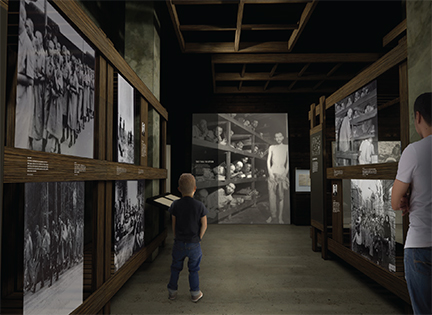November opening for WWII Museum’s Liberation Pavilion

The National WWII Museum will open the highly anticipated Liberation Pavilion, its final permanent exhibit hall, and officially dedicate the Col. Battle Barksdale Parade Ground, an outdoor gathering space in the heart of the New Orleans campus, on Nov. 3 — in time for the last surviving members of the World War II generation to experience what has been built in their honor.
One emphasis of the new pavilion will be bearing witness to the Holocaust. The pavilion will also explore the end of World War II, the postwar years and how the war continues to affect the world today. The three-story pavilion, made possible through the support of private donors and the State of Louisiana, houses two floors of exhibit space featuring first-person accounts, iconic imagery, powerful artifacts and immersive environments, as well as a third-floor theater offering audiences a brand-new cinematic experience.
The November celebration will mark the completion of the $400 million Road to Victory Capital Campaign that has propelled the extraordinary growth of the Museum’s campus from one exhibit hall to seven pavilions over the past two decades. The public announcement of this historic milestone capped off the Museum’s June 6 commemorations of the 79th anniversary of the D-Day invasion of Normandy, and the 23rd anniversary of the Museum’s grand opening.
“The National WWII Museum has the incredible responsibility and privilege of telling one of the most important stories in human history. Liberation Pavilion will be a powerful addition to the Museum experience, providing visitors with a deeper understanding of the cost of our victory and the war’s enduring impacts,” said Stephen J. Watson, museum president and CEO. “This milestone moment will be a celebration of the Museum’s unbelievable growth but also a special opportunity to pay tribute to the men and women who helped secure victory in World War II and reflect on our own role in carrying on their legacies.”

Artist rendering of Holocaust liberation exhibit
The Pavilion’s first floor galleries, “Finding Hope in a World Destroyed,” will honor the sacrifices of the WWII generation and explore the immense cost of war with exhibits on the Holocaust, Anne Frank, faith in wartime, and the Monuments Men and Women. The first floor will also include a panoramic theater with personal testimonies from Holocaust survivors and the U.S. forces who liberated them, as well as an interfaith chapel to provide a quiet space for contemplation.
The second floor of Liberation, the Goldring Family Foundation and Woldenberg Foundation “Forces of Freedom at Home and Abroad (1945–Present),” will explore the war’s impact in the postwar period and its lasting legacies today. Exhibits will examine the rebuilding efforts of a world destroyed, the war crimes trials, the emergence of the U.S. as a world “superpower,” movements for social change and civil rights, new technological innovations and the war’s impact on foreign policy. An interactive gallery will provide a reflective space for visitors to voice their thoughts on the war’s legacy and what it means today.
On the third floor, the Priddy Family Foundation Freedom Theater will offer audiences a multimedia experience focused on what was at stake during World War II and the meaning of Allied victory. The production, being developed by The Hettema Group, will highlight how freedom and democracy were nearly extinguished from the world in the 1930s and 1940s while also portraying how America helped to defend and promote freedom and human rights after World War II. At a pivotal moment in the show, the theater audience platform itself will rotate.
Adjacent to Liberation Pavilion, the 24,000-square-foot Col. Battle Barksdale Parade Ground is an impressive outdoor space at the heart of the Museum’s campus. Its dedication comes almost two decades after the first major donation to the Road to Victory Capital Campaign by Donna and Jim Barksdale, then a Museum trustee, who earmarked the funds for a future parade ground in honor of his uncle Colonel Battle Barksdale, an Army officer in World War II.
The beginnings of the Museum date back to 1990, when University of New Orleans professors Stephen Ambrose, PhD, and Gordon H. “Nick” Mueller, PhD, discussed plans for a modest D-Day museum.
“We have achieved something beyond what Stephen Ambrose and I could have imagined when we set out to create The National D-Day Museum,” said Mueller, Museum president and CEO emeritus. “Steve often spoke of his dream for the Museum to serve as a ‘love song to democracy,’ a dream that has come true over the past 20 years. Now, we can more fully thank the WWII generation and show the world what their fight for freedom means today.”
The Nov. 3 grand opening will be part of the Museum’s weeklong “D-Day to Liberation: Road to Victory Celebration,” which will include a series of private and public events to honor the WWII generation and thank the many supporters who made the campus expansion possible. During this weeklong celebration, The National WWII Museum will also host Medal of Honor Recipients and their families in New Orleans for the 2023 Congressional Medal of Honor Society Convention, presented by the Stephen G. and Regina Oswald Foundation.



